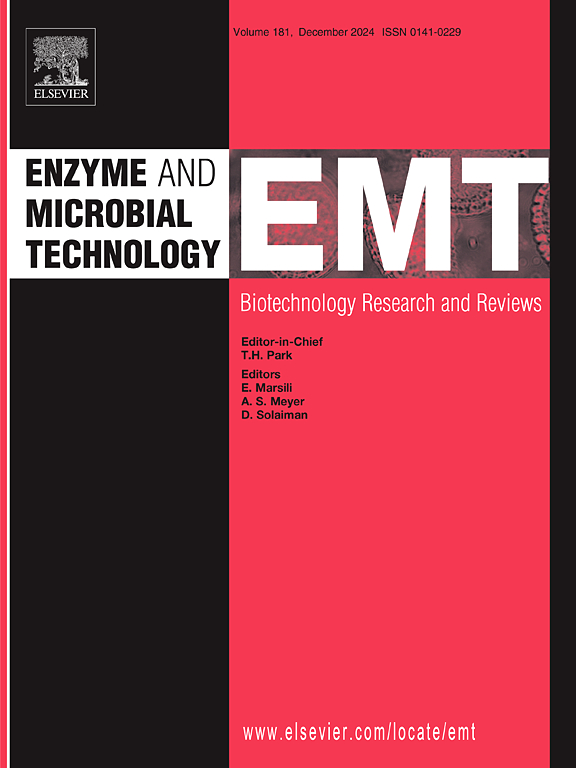利用统计设计方法优化新型Pantoea sp. (PQ584882)固态发酵协同生产木聚糖纤维素水解酶的理化参数
IF 3.7
3区 生物学
Q2 BIOTECHNOLOGY & APPLIED MICROBIOLOGY
引用次数: 0
摘要
木聚糖酶和纤维素酶由于其在食品、造纸、生物燃料和制药工业中的广泛应用而变得越来越重要。然而,目前这些酶的生产依赖于昂贵的底物,据估计,超过30% %的生产费用归因于这些底物。本研究的目的是优化理化参数,以获得木聚糖酶的最大产量。纤维素酶来自Pantoea sp. (PQ584882)。采用Plackett-Burman设计(PBD)和中央复合设计(CCD)对生产条件进行了统计优化。通过PB设计确定的显著变量包括温度、底物与水分比、K2HPO4、蛋白胨、表面活性剂、接种量、接种年龄、培养时间和pH,并利用CCD方法进一步优化。该优化过程揭示了影响木聚糖酶的主要因素。纤维素酶生产,最佳条件为温度40◦C,水分比例15 mL;K2HPO4 6 mM;胨,1.55 %;蓖麻油0.5 %;接种量,1.55 % (v/w);接种年龄,18 h;孵化时间,87 h。优化后的CCD模型显示了1.84倍的木聚糖酶;纤维素产量比PB设计方法。这些发现表明,麦麸作为一种可利用的农业废弃物,可以替代传统的底物、山毛榉木聚糖和羧甲基纤维素,用于生产木聚糖酶。纤维素酶与实现更高的生产水平的可能性优化采用统计设计的方法。本文章由计算机程序翻译,如有差异,请以英文原文为准。
Optimization of physico-chemical parameters for synergistic production of xylano-cellulolytic enzymes by novel Pantoea sp. (PQ584882) under solid-state fermentation using statistical design approach
Xylanase and cellulase have become increasingly significant due to their versatile applications in the food, paper, biofuel, and pharmaceutical industries. Nevertheless, the current production of these enzymes relies on costly substrates, with estimates indicating that over 30 % of the production expenses are attributed to these substrates. The objective of this study is to optimize the physicochemical parameters for obtaining the maximum production of xylanase & cellulase enzyme from Pantoea sp. (PQ584882). The production conditions were statistically optimized using Plackett-Burman design (PBD) and Central Composite design (CCD). The significant variables identified through PB design including temperature, substrate-to-moisture ratio, K2HPO4, peptone, surfactant, inoculum size, inoculum age, incubation time, and pH were further optimized using the CCD approach. This optimization process revealed the most influential factors affecting xylanase & cellulase production, with optimal conditions observed at a temperature of 40◦C, Moisture Proportion, 15 mL; K2HPO4 6 mM; peptone, 1.55 %; Castor oil 0.5 %; inoculum size, 1.55 % (v/w); inoculum age, 18 h; an incubation time, 87 h. The optimized CCD model displayed a 1.84-fold greater xylanase & cellulose production than the PB design approach. These findings suggest that wheat bran, a readily available agro-waste, could be a feasible alternative to the conventional substrate, beechwood xylan and CMC (Carboxy methyl cellulose) for the production of xylanase & cellulase enzymes with the possibility of achieving higher production levels optimized by using a statistical design approach.
求助全文
通过发布文献求助,成功后即可免费获取论文全文。
去求助
来源期刊

Enzyme and Microbial Technology
生物-生物工程与应用微生物
CiteScore
7.60
自引率
5.90%
发文量
142
审稿时长
38 days
期刊介绍:
Enzyme and Microbial Technology is an international, peer-reviewed journal publishing original research and reviews, of biotechnological significance and novelty, on basic and applied aspects of the science and technology of processes involving the use of enzymes, micro-organisms, animal cells and plant cells.
We especially encourage submissions on:
Biocatalysis and the use of Directed Evolution in Synthetic Biology and Biotechnology
Biotechnological Production of New Bioactive Molecules, Biomaterials, Biopharmaceuticals, and Biofuels
New Imaging Techniques and Biosensors, especially as applicable to Healthcare and Systems Biology
New Biotechnological Approaches in Genomics, Proteomics and Metabolomics
Metabolic Engineering, Biomolecular Engineering and Nanobiotechnology
Manuscripts which report isolation, purification, immobilization or utilization of organisms or enzymes which are already well-described in the literature are not suitable for publication in EMT, unless their primary purpose is to report significant new findings or approaches which are of broad biotechnological importance. Similarly, manuscripts which report optimization studies on well-established processes are inappropriate. EMT does not accept papers dealing with mathematical modeling unless they report significant, new experimental data.
 求助内容:
求助内容: 应助结果提醒方式:
应助结果提醒方式:


